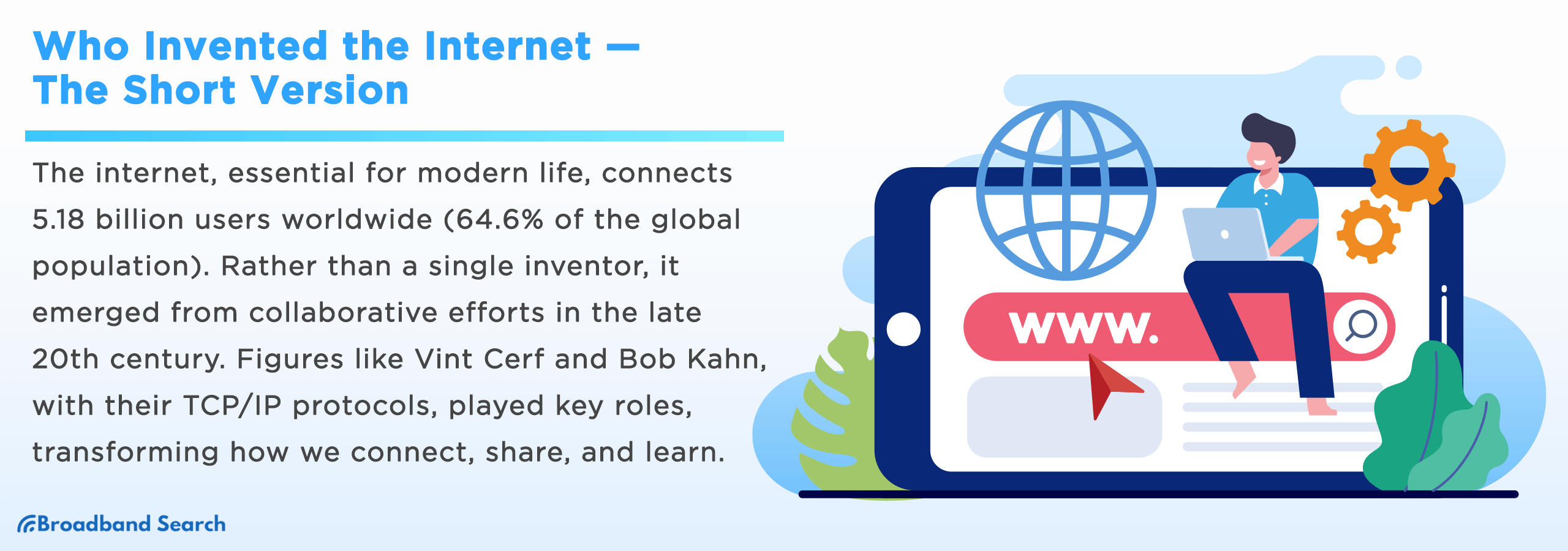The internet, a cornerstone of modern communication and information exchange, touches nearly every aspect of our lives. It's not just a tool; it's a lifeline in a world that thrives on connectivity. Consider this: there are 5.18 billion internet users worldwide, encompassing 64.6 percent of the global population.
So, who sparked this digital revolution? The credit doesn't go to a single inventor. Instead, it was a collaborative effort that blossomed in the late 20th century. Key figures like Vint Cerf and Bob Kahn, who developed the TCP/IP protocols, played pivotal roles. Their work, along with contributions from many others, crafted the internet's backbone, transforming how we connect, share, and learn.
Early Concepts and Theoretical Foundations
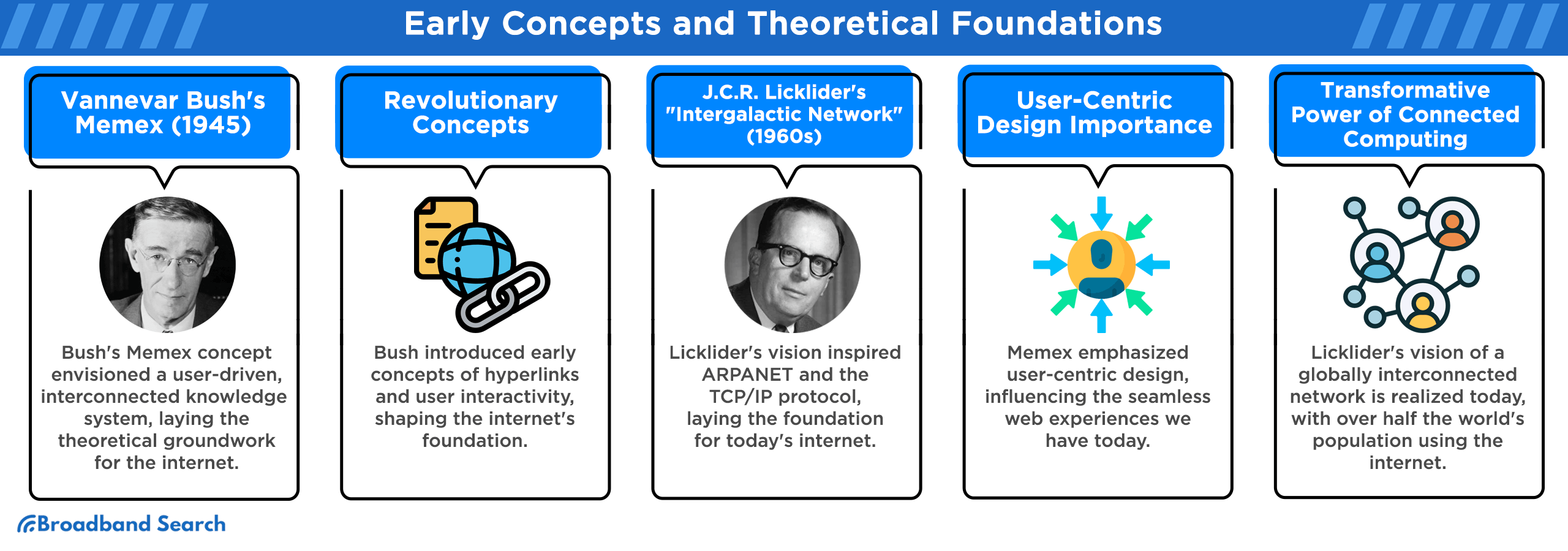
Vannevar Bush's Memex Concept (1945)
Imagine a machine that could store a vast library of information, all accessible at your fingertips. This was Vannevar Bush's vision in 1945, long before the internet as we know it. His concept, dubbed the Memex, was about storing data and creating a web of interconnected knowledge. Bush foresaw a future where information could be linked and retrieved effortlessly, a groundbreaking idea that laid the theoretical foundation for the internet.
Bush's vision extended beyond mere data storage; he imagined a user-driven experience. The Memex was to be an extension of the user's memory, allowing for personalized trails of knowledge. This early concept of hyperlinks and user interactivity was revolutionary. It set the stage for the internet's development, highlighting the importance of user-centric design in digital information systems. As we surf the web today, effortlessly jumping from page to page, it's remarkable how Bush's vision, once a mere concept, has become a daily reality for billions.
J.C.R. Licklider's "Intergalactic Network" (1960s)
In the 1960s, J.C.R. Licklider, an American psychologist and computer scientist, introduced the groundbreaking concept of an "Intergalactic Network." His vision? A globally interconnected set of computers through which everyone could quickly access data and programs from any site.
Licklider's concept laid the foundation for the modern internet. It propelled the development of ARPANET, the first network to implement the TCP/IP protocol suite that underpins today's internet. His vision of a universally connected world now resonates more than ever, with over half the global population using the internet, demonstrating his foresight and the transformative power of connected computing.
Development of Networking Technology
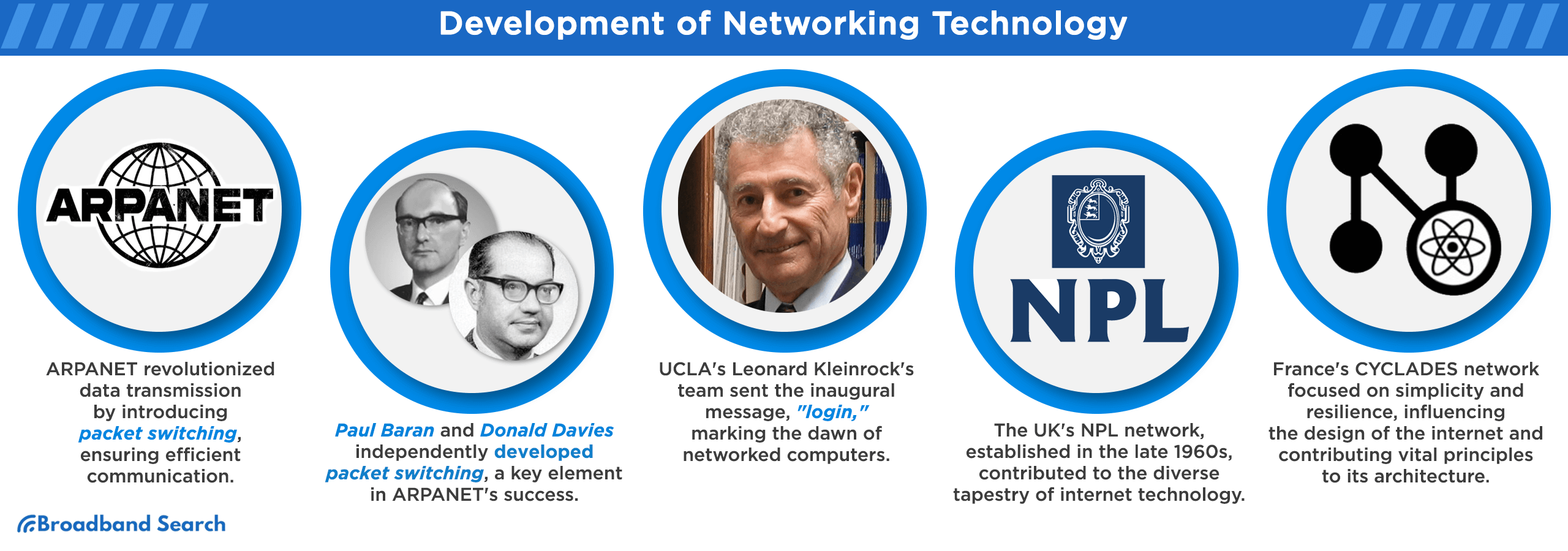
ARPANET (1960s-1970s)
The 1960s and 70s marked a pivotal era in internet history with the development of ARPANET, funded by the U.S. Department of Defense. This project wasn't just about building a network; it was about reimagining how data could travel across vast distances. The goal was ambitious: create a robust, fault-tolerant communication network using decentralized control.
Central to ARPANET's success was the innovation of packet switching, a concept developed independently by Paul Baran and Donald Davies. Packet switching revolutionized data transmission, allowing information to be broken into smaller, manageable packets sent independently over the network. This approach was efficient and powerful, ensuring data integrity even in challenging network conditions.
The first real test came in 1969 when Leonard Kleinrock's team at UCLA sent the first message over ARPANET. This wasn't just a technical achievement; it was the dawn of a new era in communication. That first message, "login", which famously crashed after just the "lo," marked the beginning of a journey towards a connected world, showing the immense potential of networked computers.
Other Early Networks
While ARPANET was making strides in the USA, the UK's National Physical Laboratory (NPL) network embarked on its own journey in networking technology. Established in the late 1960s, the NPL network pioneered a different approach to data communication, contributing to the diverse tapestry of internet technology. Its development showcased the global race towards a connected world, highlighting the universal curiosity and ambition driving this era.
Across the channel, France's CYCLADES network emerged in the early 1970s. CYCLADES focused on simplicity and network resilience and influenced the internet's design, particularly in developing datagram protocols. Though less known, this network provided vital insights and principles integral to today's internet architecture.
Innovations Leading to the Modern Internet
TCP/IP Protocol (1980s)
In the 1980s, the internet's development took a quantum leap with the TCP/IP protocol, spearheaded by Vint Cerf and Bob Kahn. This protocol became the language of the internet, allowing different computer networks to communicate seamlessly. It's like the Rosetta Stone of the digital world, translating diverse network languages into a universal dialect.
1983 was a landmark year, as ARPANET adopted TCP/IP as its standard protocol. This decision wasn't just a technical upgrade but a transformative step that unified multiple, isolated networks into an interconnected network of networks – what we now know as the internet.
This innovation by Cerf and Kahn was a game-changer. It provided a robust, scalable framework still at the heart of internet communication.
Email and Usenet
In 1971, the internet revolutionized personal communication with Ray Tomlinson's invention of email. This breakthrough transformed how messages were exchanged, introducing the now-ubiquitous '@' symbol in email addresses. Tomlinson's innovation wasn't just a technical feat; it redefined global communication, making it instant and borderless.
Fast forward to 1979, and another milestone emerged with the development of Usenet. Envisioned as a global messaging and file-sharing system, Usenet functioned like a primitive version of today's forums and social media platforms. It fostered communities across various interests, connecting people in ways previously unimaginable.
These innovations – email and Usenet – were more than just new technologies. They were harbingers of a new communication era, preluding the modern internet's social dynamics.
The Widespread Adoption of the Internet
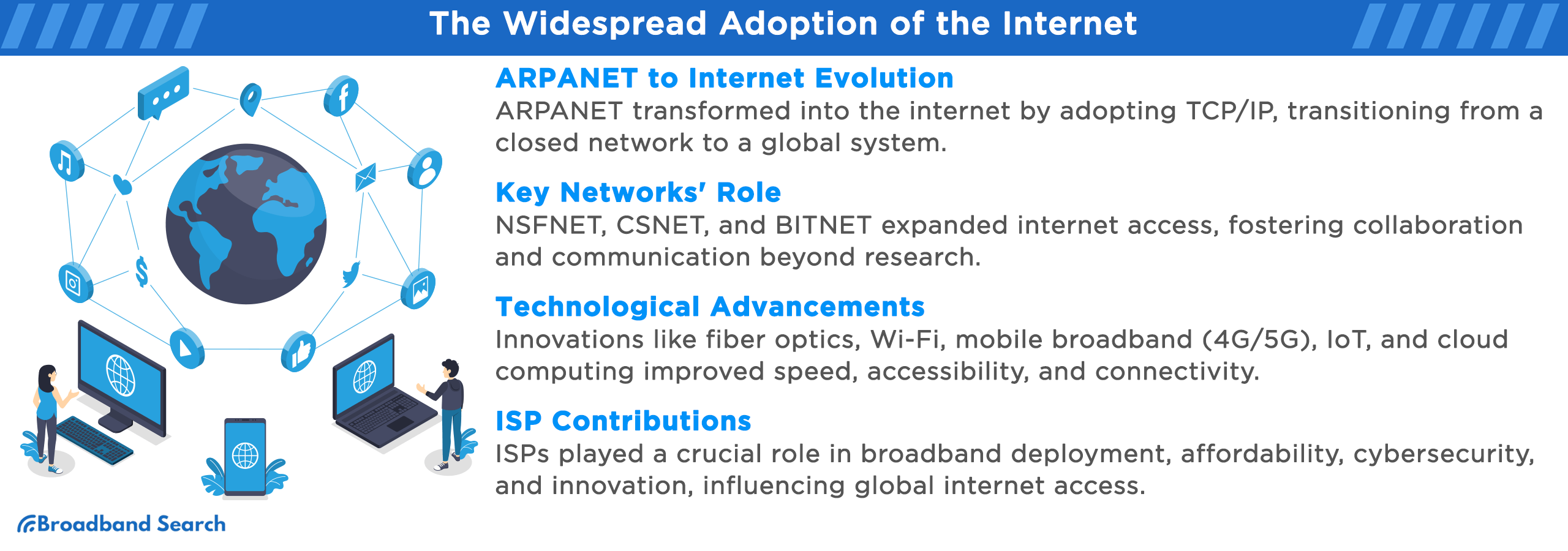
From ARPANET to Modern Internet
ARPANET, the precursor to the internet, was initially a closed network used by academics and the military. But it sparked a revolution. By adopting TCP/IP, this network evolved into a model for a global system of interconnected computer networks known as the internet. It was a gradual transition from a specialized project to a public infrastructure.
The Role of NSFNET and Other Networks in Expanding Internet Access:
- NSFNET: The National Science Foundation Network, or NSFNET, provided a backbone for internet connectivity in the 1980s. It linked major universities, enabling research and education communities to access and share resources more efficiently.
- CSNET (Computer Science Network): CSNET connected academic computer science departments. This network played a crucial role in bringing together researchers, fostering collaboration, and sharing knowledge across institutions.
- BITNET (Because It's Time Network): BITNET, primarily an educational network, emphasized messaging and file sharing. It expanded internet use beyond research, contributing to the broader academic and social communication that prefigured today's internet.
This journey from ARPANET to the modern internet reflects a transition from a specialized tool to a global necessity. The roles played by networks like NSFNET and CSNET, and the later addition of commercial networks, were critical in this transformation. Collectively, they paved the way for the internet to become today's expansive, inclusive global network.
Technological Advancements and Public Access
The internet's widespread adoption owes much to remarkable technological advancements. Here are five key innovations:
- Fiber Optics: Revolutionized data transmission with higher bandwidth and speed. Fiber optic cables, transmitting data as light, significantly outperform traditional copper cables. Latest data shows a global fiber optics market size reaching USD 9.12 billion by 2025.
- Wireless Networks (Wi-Fi): Wi-Fi transformed internet access, allowing wireless connectivity. Its latest iteration, Wi-Fi 6, offers faster speeds, increased capacity, and better performance in crowded areas.
- Mobile Broadband (4G/5G): The advent of 4G and 5G networks enhanced mobile internet connectivity. 5G technology promises speeds up to 100 times faster than 4G, revolutionizing internet access on the go.
- Internet of Things (IoT): IoT connects everyday devices to the internet, enhancing automation and efficiency. By 2025, there are expected to be over 75 billion IoT connected devices worldwide.
- Cloud Computing: Enabled decentralized data storage and processing. Cloud computing offers scalability, flexibility, and cost savings, significantly impacting how data is stored and accessed.
Role of Internet Service Providers (ISPs)
- Broadband Deployment: ISPs have played a crucial role in expanding internet coverage, with services now reaching 91.8 percent of U.S. households.
- Affordability Options: Many ISPs offer affordable plans, contributing to increased internet adoption. In 2023, 65.7 percent of the global population has internet access.
- Cybersecurity Measures: ISPs implement security protocols to protect users from cyber threats. Cybersecurity market spending by ISPs is projected to reach $215 billion by 2024.
- Innovative Services: ISPs continuously innovate, offering services like IPTV and smart home solutions, enhancing user experience. IPTV subscribers worldwide are expected to reach 412 million subs by 2029.
Internet as a Global Phenomenon
The World Wide Web
In 1989, while at CERN, Tim Berners-Lee conceptualized the World Wide Web. Not to be confused with the internet itself, the Web is like a vast, sprawling library that Berners-Lee built on the existing internet infrastructure. It's a system of interlinked hypertext documents – a digital universe of websites and web pages accessible via the internet.
How the Web Differs from and Interacts with the Internet:
- Nature and Function: The internet is a global network connecting millions of computers. The World Wide Web, however, is a way to access information over this medium.
- Data Access: On the internet, data transfers through various protocols like FTP, SMTP, etc. The Web uses HTTP/HTTPS protocols specifically for accessing web pages.
- Interactivity and User Experience: While the internet is the foundation, the Web provides an interactive, user-friendly interface. Think of the internet as the tracks and the Web as the train providing the journey experience.
- Content Type: The internet encompasses a wider range of data, including emails, files, and direct messages. In contrast, the Web focuses mainly on web pages and websites.
- Development and Evolution: The development of the internet was driven by hardware and infrastructure advancements. The evolution of the Web, on the other hand, has been propelled by software, browsers, and web technologies.
Tim Berners-Lee's World Wide Web is the vehicle that made the internet user-friendly and universally accessible, turning it into the indispensable tool it is today. His exploration helps us appreciate the Web's role in shaping our digital lives and the internet's broader scope.
Internet in the 21st Century
In the 21st century, the internet has become a crucial part of modern society, impacting numerous aspects of life globally. Here are five key areas where the internet has made a significant impact:
- Communication Revolution: The internet has drastically transformed communication, enabling instant messaging, emails, and video calls. Predictions show over 4.37 billion users in 2023, followed by approximately 4.48 billion in 2024 and 4.59 billion users by 2025.
- Information Access: From academic research to daily news, the internet provides unprecedented access to information. As of 2023, Google processes over 3.7 billion searches daily.
- Economic Impact: The internet is crucial for business operations, e-commerce, and the global economy. Global e-commerce sales will rise to approximately $6.38 trillion by 2024.
- Social Networking: Platforms like Facebook and Twitter have redefined social interactions, enabling people to maintain relationships and build new ones online. Facebook reported 2.99 billion active users in 2023. However, some are also concerned about the adverse effects of social media.
- Education and E-Learning: Online learning platforms have made education more accessible. The internet supports diverse learning resources, from online courses to educational videos. As of March 2023, Coursera had 124 million learners.
Looking ahead to 2024, internet technology trends point to further exciting developments:
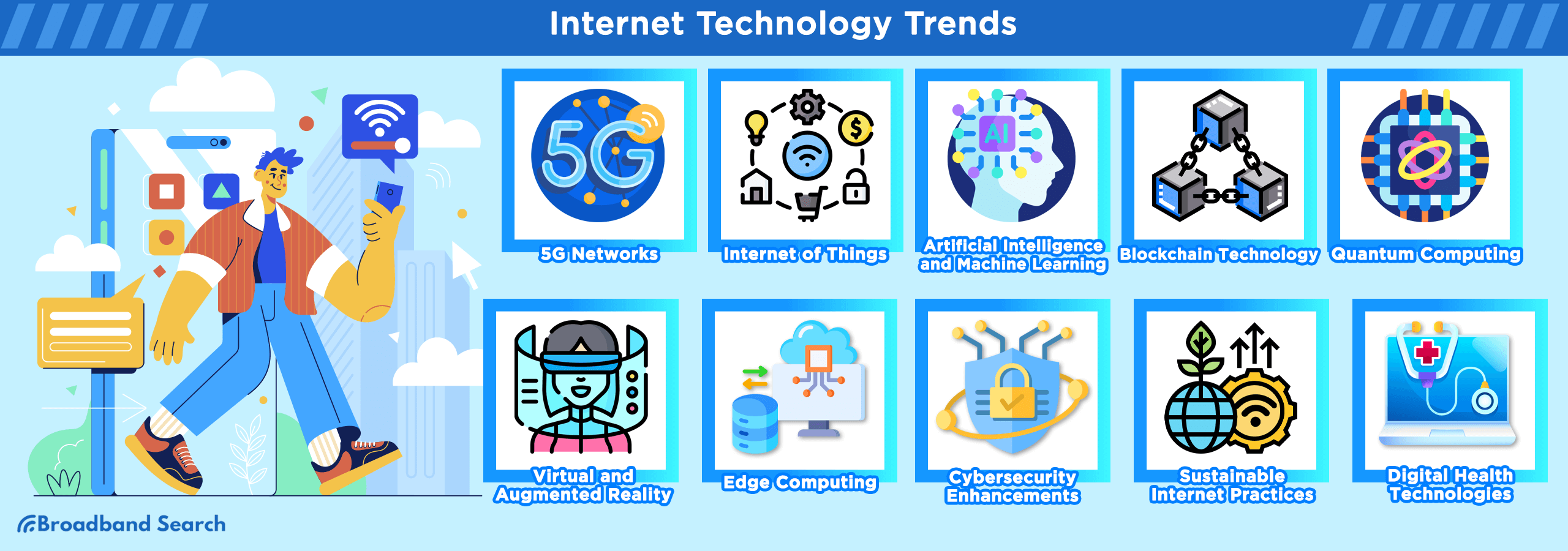
- 5G Networks: 5G Networks are expected to revolutionize internet speed and connectivity, enhancing online experiences and enabling new technologies like IoT. 5G networks are predicted to cover 40 percent of the world by 2024.
- Internet of Things (IoT): Increasing connectivity of everyday devices to the internet, the IoT will facilitate smart homes, cities, and industries. There will be 75.44 billion IoT-connected devices by 2025.
- Artificial Intelligence and Machine Learning: These technologies are becoming integral to internet services for personalization and automation. AI market revenue is expected to reach $126 billion by 2025.
- Blockchain Technology: Beyond cryptocurrencies, blockchain offers secure, decentralized data management for various online applications. Blockchain technology market size is projected to reach $39.7 billion by 2025.
- Quantum Computing: This has the potential to revolutionize internet security and data processing speeds. Global quantum computing market is projected to reach $65 billion by 2030, though research is still in the earlier stages.
- Virtual and Augmented Reality: These technologies are transforming online interactions and experiences. The global AR & VR market is anticipated to experience a compound annual growth rate (CAGR) of 12.60 percent from 2023 to 2028, reaching a market volume of $58.1 billion by the end of 2028.
- Edge Computing: This enhances cloud computing by processing data closer to the source, reducing latency. The global edge computing market is expected to reach $43.4 billion by 2027.
- Cybersecurity Enhancements: As internet usage grows, so does the need for advanced cybersecurity measures. The cybersecurity market is projected to grow to $266.2 billion by 2027.
- Sustainable Internet Practices: Focus on reducing the environmental impact of Internet infrastructure. Data centers are moving towards using 100 percent renewable energy by 2025.
- Digital Health Technologies: The internet is increasingly vital for telemedicine, data management, and healthcare research. The global digital health market is estimated to reach $504.4 billion by 2025.
The Takeaway
The invention of the Internet is a testament to human collaboration, a story of collective genius rather than a singular eureka moment. From early theoretical concepts to the development of ARPANET, and the pivotal introduction of the World Wide Web, each milestone represented a leap forward in connecting the world. Reflecting on its evolution, we understand that the internet's journey is far from over, continuing to evolve and shaping our world in ways once unimaginable.
FAQ
Who funded the initial development of the internet?
The U.S. government, particularly through DARPA (Defense Advanced Research Projects Agency), was instrumental in funding early internet development. Academic institutions and private companies also played key roles, forming a collaborative network that fueled technological advancements.
What were the first applications and services available on the internet?
Initial internet services included email, revolutionizing communication. Newsgroups fostered community discussions, and early web browsers, although primitive, laid the groundwork for the modern internet experience.
How did the introduction of smartphones and mobile technology impact the internet?
Smartphones revolutionized internet usage by greatly enhancing accessibility. They spurred the creation of mobile-optimized services and applications, profoundly changing how users interact with the web and each other.
What were the major security concerns in the early stages of the internet, and how were they addressed?
In its infancy, the internet faced significant security challenges such as early viruses and digital trespassers. Developing early encryption protocols and security measures was essential in protecting data and maintaining user trust in this burgeoning technology.
How did the internet transition from a research tool to a public utility?
The internet's evolution into a public utility was driven by policy shifts, technological advancements, and its commercialization. These factors collectively democratized access, making the internet an integral part of daily life.

